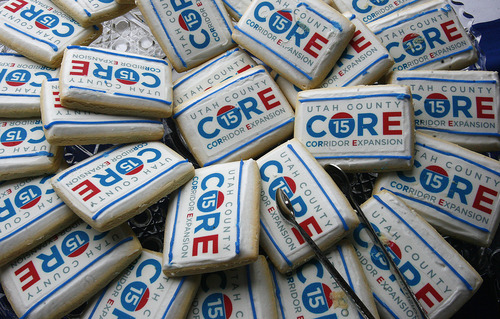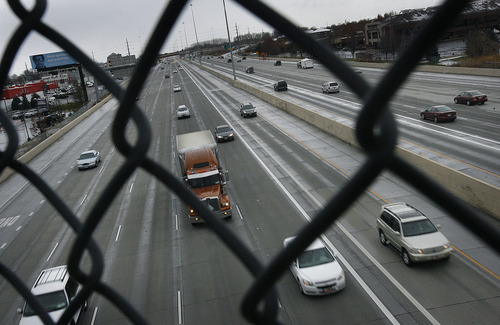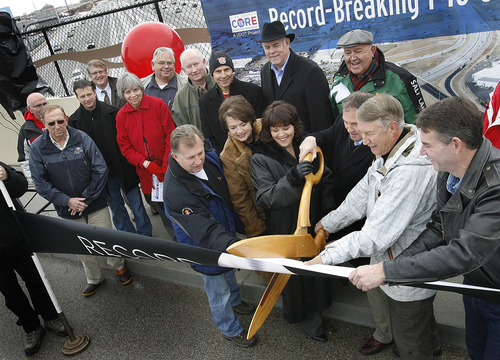This is an archived article that was published on sltrib.com in 2012, and information in the article may be outdated. It is provided only for personal research purposes and may not be reprinted.
In snowy, freezing ceremonies, officials celebrated completion Saturday of two of the state's largest highway projects ever — the $1.73 billion rebuild of Interstate 15 in Utah County and the $730 million first phase of the Mountain View Corridor in western Salt Lake County.
John Njord, executive director of the Utah Department of Transportation, said it was like "we have delivered the World Series and … the Super Bowl all in one day."
Gov. Gary Herbert added, "It looks like Christmas to me" as the long-sought projects were celebrated amid falling snow and many happy people.
Njord even had a gift for the governor. UDOT had previously announced the I-15 project would come in about $230 million under budget, but it is actually $260 million under — so $30 million more can go to other projects.
The I-15 project rebuilt 24 miles between Lehi and Spanish Fork — with state money only, and no federal aid. It replaced original asphalt with concrete designed to last 40 years; added two lanes in each direction; extended express lanes for its entire length; and rebuilt or replaced 63 bridges and 10 interchanges. Lanes were opened last month, but some finishing work continued until the past week.
Njord said it was the "fastest billion-dollar highway project ever built in America," finished in 35 months. That occurred as it managed to keep most of the original number of lanes open most of the time.
The ribbon cutting was held on the Sam White Bridge over I-15 in American Fork. Njord noted that the 354-foot bridge, like many in the project, was built off to the side of I-15 and moved into place in one night — and it was the longest bridge in the Western Hemisphere to ever be moved like that.
"The technology to move it into place in hours instead of months is indicative of all the work that took place on this project" to complete it quickly and keep traffic moving, Njord said.
Sen. John Valentine, R-Provo, said the state almost chose not to build the project as the recession hit — and almost opted instead to wait for federal funds later — but gambled that construction and financing costs would be low in the slow economy and felt it was needed to keep people working.
"Today we look like heroes. We could have been heels," Valentine said.
Three hours before the I-15 ribbon cutting on Saturday, Herbert and other officials opened the Mountain View Corridor in ceremonies in West Jordan.
Despite a snowstorm, about 150 people — fueled with contractor-supplied hot chocolate, commemorative knit caps and hand-warmers — took up the state's offer to run part of the new highway in a 5K "Polar Bear Fun Run" before it opened to traffic.
"At least everyone who showed up will remember this day," said Dannie McConkie, a member of the Utah Transportation Commission, as he rubbed hands together to keep warm in the storm.
Mountain View now offers a 15-mile stretch of two lanes of traffic — plus pedestrian and bike trails — in each direction at about 5700 West between 16000 South and 5400 South. Lanes are widely separated now — and the lanes of a future freeway will be built eventually in the median.
Sections between 16000 South and Old Bingham Highway had been opened in phases earlier this year, but a section from there to 5400 South opened Saturday. Mountain View took 32 months to build. It will eventually become a 35-mile freeway between I-80 near Salt Lake City International Airport and I-15 in Lehi.
Herbert said the two projects are important not only to improving transportation and reducing congestion, but also "it is about economic development. If you want this state to thrive economically, you've got to have a transportation system that works."
The two projects used mountains of material and millions of man-hours of work.
For example, UDOT said the I-15 project use 7 million work hours, the same as the Empire State Building; 2.8 million square yards of concrete pavement, enough to pave a sidewalk from coast to coast; 96 million pounds of steel; and moved 7.7 million tons of dirt.
Mountain View used 335,250 tons of asphalt, enough to fill three modern aircraft carriers; moved 6 million cubic yards of dirt, enough to fill 1,568 Olympic-sized swimming pools; and used 325,000 square yards of concrete, enough to cover 51 football stadiums.
The I-15 project did have some major controversy at its beginning.
That came amid disclosures that UDOT quietly paid $13 million to a losing bidder for the $1.1 billion construction contract. That bidder asserted it was cheated out of the contract after bid scoring was tweaked, and Provo River Constructors instead won by one point. That company's officials had contributed $82,500 to Herbert in months before the contract was awarded.
Audits later found no wrongdoing or political pressure by UDOT and Herbert over the bid, but a state auditor's report said it could not determine whether the bid process and settlement payment were fair because of lack of documentation.
That review also criticized UDOT for not concealing identities of the bidders, providing misleading information to one bidder about how proposals would be evaluated and for including on the UDOT evaluation team a person married to an employee of one of the bidding contractors.







